Science
Pregnant and addicted: Homeless women see hope in street medicine
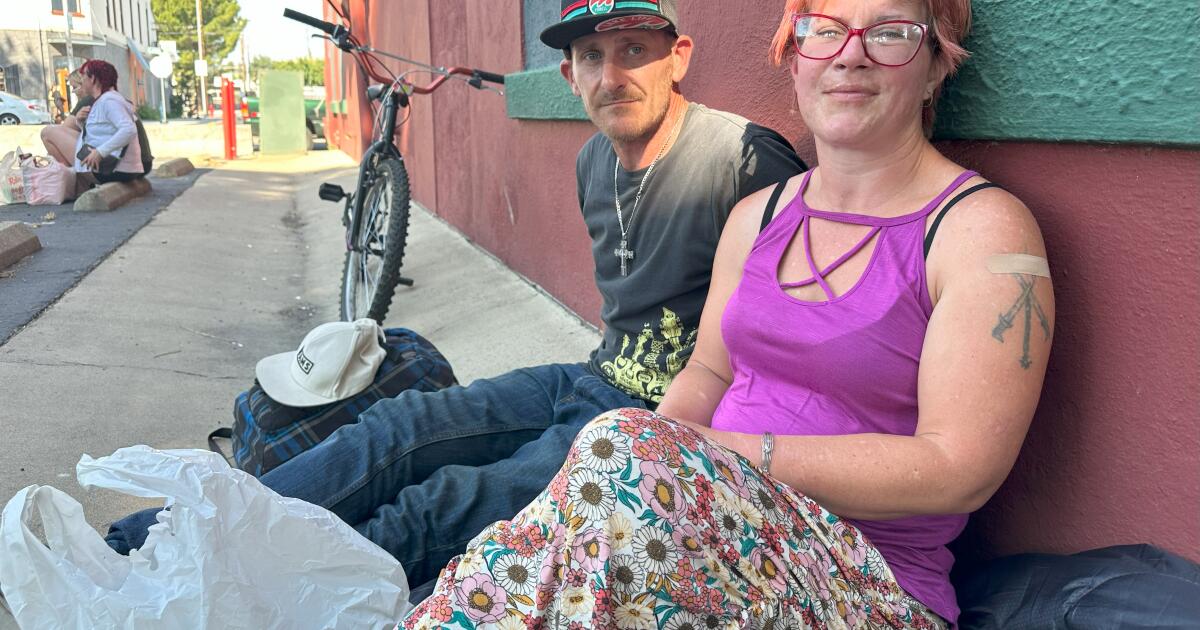
Five days after giving birth, Melissa Crespo was already back on the streets, recovering in a damp, litter-strewn water tunnel, when she got the call from the hospital.
Her baby, Kyle, who had been born three months prematurely, was in respiratory failure in the neonatal intensive care unit and fighting for his life.
The odds had been against Kyle long before he was born last summer. Crespo, who was abused as a child, was addicted to fentanyl and meth — a daily habit she found impossible to kick while living homeless.
Crespo got a ride to the hospital and cradled her baby in her arms as he died.
“I know this happened because of my addiction,” Crespo said recently, just after a nurse injected her on the streets of downtown Redding with a powerful antipsychotic medication. “I’m trying to get clean, but this is an illness and it’s so hard while you’re out here.”
Crespo, 39, is among a growing number of homeless pregnant women in California whose lives have been overrun by hard drug use, a deadly coping mechanism many use to endure trauma and mental illness. They are a largely unseen population that, in battling addiction, has lost children — whether to death or local child welfare authorities.
She and other women are now receiving care from specialized street medicine teams fanning across California to treat homeless people wherever they are — whether in squalid encampments, makeshift shantytowns clustered along rivers, or vehicles they stealthily maneuver from one neighborhood to another in search of a safe place to park.
Dr. Kyle Patton leads the street medicine team for Shasta Community Health Center in Redding.
(Angela Hart / KFF Health News)
“This is a really impoverished community, and the big thing right now is maternity care and prenatal care,” said Kyle Patton, a family doctor who leads the street medicine team for Shasta Community Health Center in Redding, about 160 miles north of Sacramento in a largely rural and conservative part of the state.
Patton, who dons hiking boots and jeans to make his rounds, has managed about 20 pregnancies on the streets since early 2022, and even totes a portable ultrasound in his backpack to find out how far along women are. He’s also helping homeless mothers who have lost custody of their children try to get sober so they can reunite.
“I didn’t expect this to be a huge part of my practice when I got into street medicine,” Patton said on a hot June day as he packed his medical van with birth control implants, tests to diagnose syphilis and HIV, antibiotics and other supplies.
“The system is broken and people lack access to healthcare and housing, so managing pregnancies and providing prenatal care has become a really big part of my job.”
Street medicine isn’t new, but it’s getting a jolt in California, which is leading the charge nationally to deliver full-service medical care and behavioral health treatment to homeless people wherever they are.
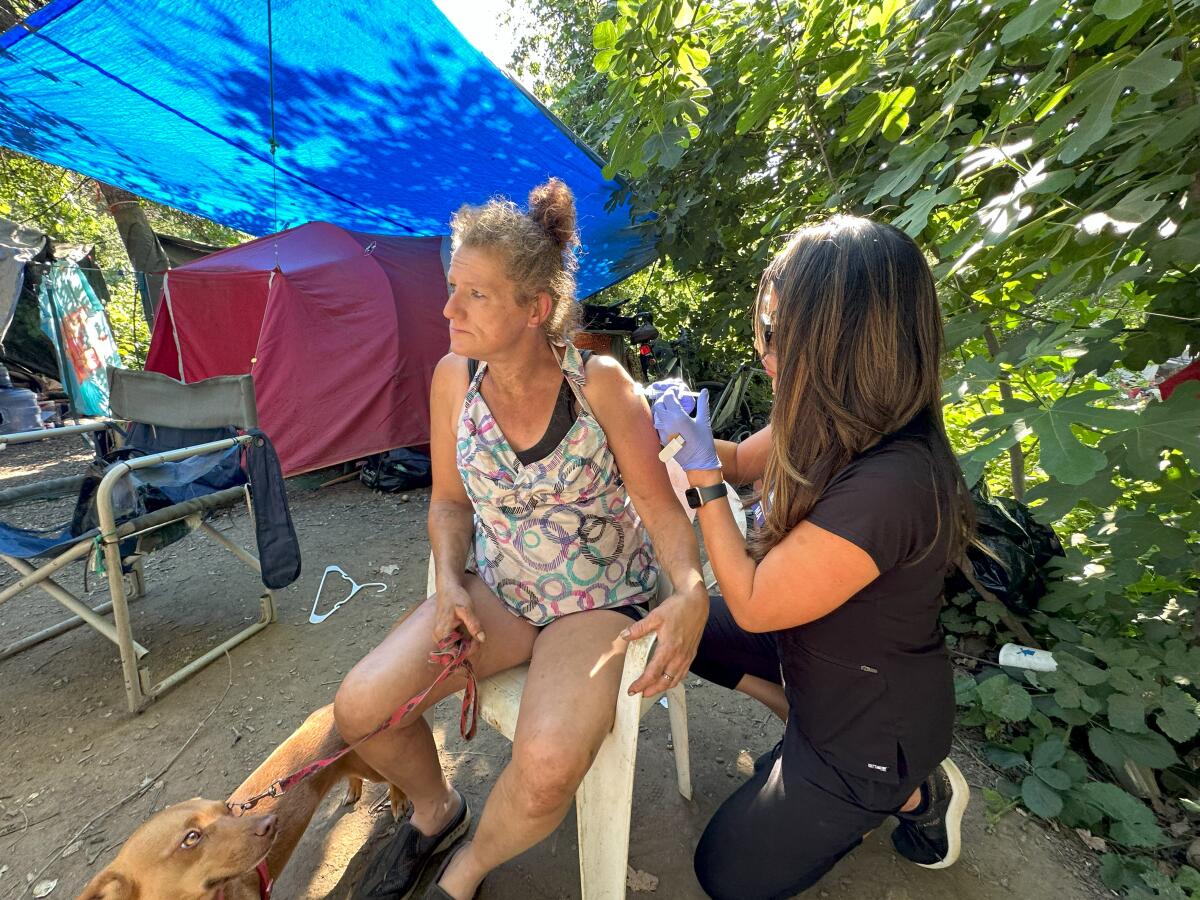
Kerry Hankins receives a shot of antipsychotic medication from Shasta Community Health Center nurse Anna Cummings.
(Angela Hart / KFF Health News)
The practice is exploding under Democratic Gov. Gavin Newsom, whose administration has plowed tens of billions of dollars into health and social services for homeless people. It has also standardized payment for street medicine providers through the state’s Medicaid program, called Medi-Cal, allowing them to be paid more consistently. The federal government expanded reimbursement for street medicine this month, making it easier for doctors and nurses around the country to get paid for delivering care to homeless patients outside of hospitals and clinics.
State health officials and advocates of street medicine say it fills a critical gap in healthcare — and could even help solve homelessness. Not only are homeless people receiving specialized treatment for addiction, mental illness, chronic diseases and pregnancy, but they’re also getting help enrolling in Medi-Cal and food assistance, and applying for state identification cards and federal disability payments.
In rare cases, street medicine teams have gotten some of the state’s sickest and most vulnerable people healthy and into housing, which supporters point to as incremental but meaningful progress. Yet they acknowledge that it’s no quick fix, and that the expansion of street medicine signals an acceptance that homelessness isn’t going away anytime soon — and that there may never be enough housing, homeless shelters and treatment beds for everyone living outside.
“Even if there is all the money and space to build it, local communities are going to fight these projects,” said Barbara DiPietro, senior director of policy for the Tennessee-based National Health Care for the Homeless Council. “So street medicine is shifting the idea to say, ‘If not housing, how can we manage folks and provide the best possible care on the streets?’”
The expansion of street medicine and other services doesn’t always play well in communities overwhelmed by growing homeless populations — and the rise in local drug use, crime and garbage that accompany encampments. In Redding and elsewhere, many residents, leaders and business owners say that expanding street medicine merely enables homelessness and perpetuates drug use.
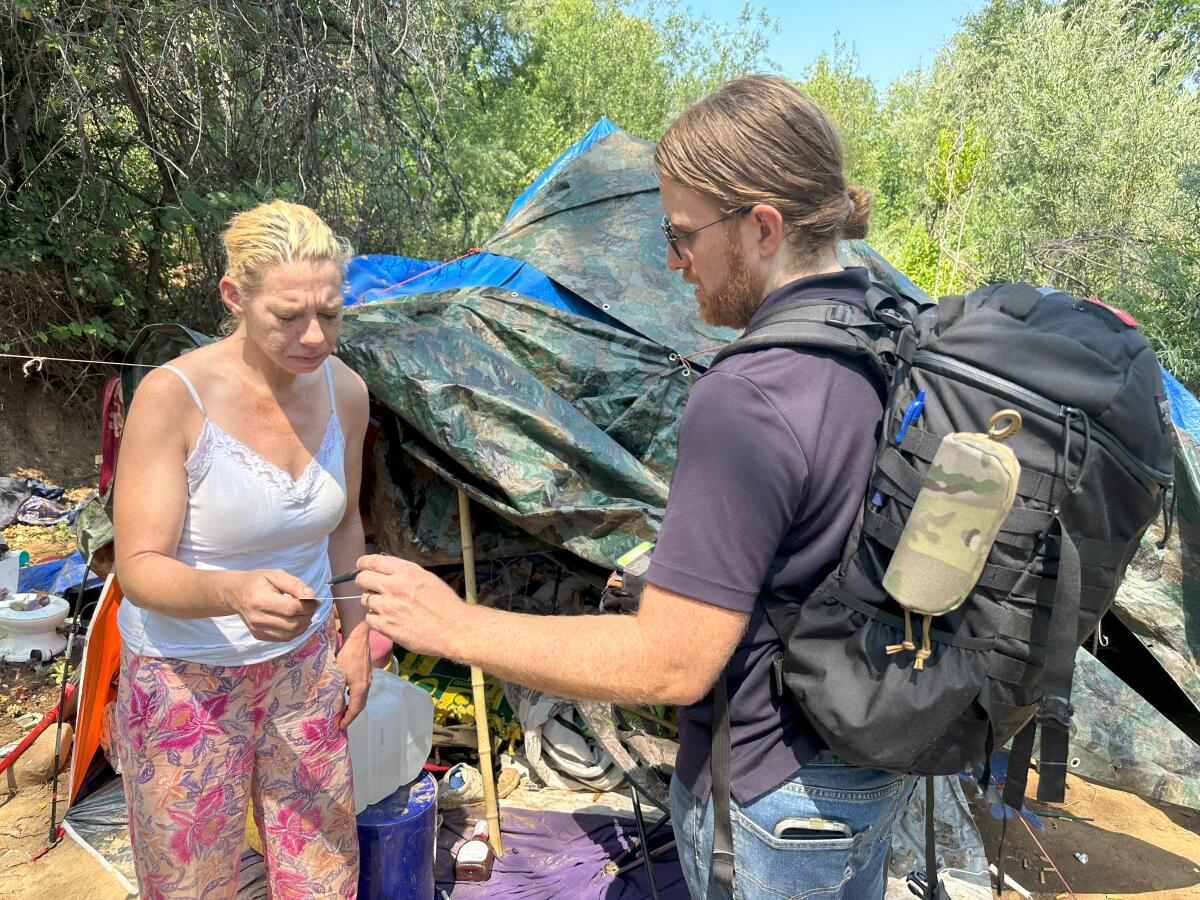
Tara Darby, who is homeless, found out she was pregnant over the summer when street medicine doctor Kyle Patton was preparing to get her on an anti-addiction treatment.
(Angela Hart / KFF Health News)
Patton acknowledges the process of getting people off drugs is long and messy. More often than not, they relapse, he said, and most expectant mothers lose their babies.
This is true even of homeless mothers like Crespo, who has been using hard drugs for nearly two decades but is desperate to get clean so she can reconnect with her four estranged children, ages 12 to 24, Crespo said. Two other children have died, one from lymphoma at age 15 and baby Kyle in August 2022, primarily because of complications from congenital syphilis.
Patton is treating Crespo for mental illness and addiction and has implanted long-acting birth control into her arm so she won’t have another unexpected pregnancy. He has also treated her for hepatitis C and early signs of cervical cancer.
Although she’s still using meth — as is her boyfriend, Kyle’s father — she’s six months sober from fentanyl and heroin, which are more deadly and addictive. “You’d think I could just get clean, but it doesn’t work that way,” Crespo said. “It’s an ongoing fight, but I’m healing.”
Patton doesn’t see Crespo’s continued drug use as a failure. His goal is to establish trust with his patients because overcoming addiction — which often is rooted in trauma or abuse — can take a lifetime, he said.
“We’re playing the long game with our patients,” he said. “They’re really motivated to seek treatment and get off the streets. But it doesn’t always work out that way.”
Patton is a young doctor. At 38, he’s on the leading edge of a movement to entrench street medicine in California, home to nearly a third of all homeless people in America. He has specialized in taking care of low-income patients from the start, first as an outreach worker in Salt Lake City and, later, in a family medicine residency in Fort Worth focused on street medicine.
In the last two years, the number of street medicine teams operating in California has doubled to at least 50, clustered primarily in Los Angeles and the San Francisco Bay Area, with 20 more in the pipeline, said Brett Feldman, director of street medicine at USC’s Keck School of Medicine.
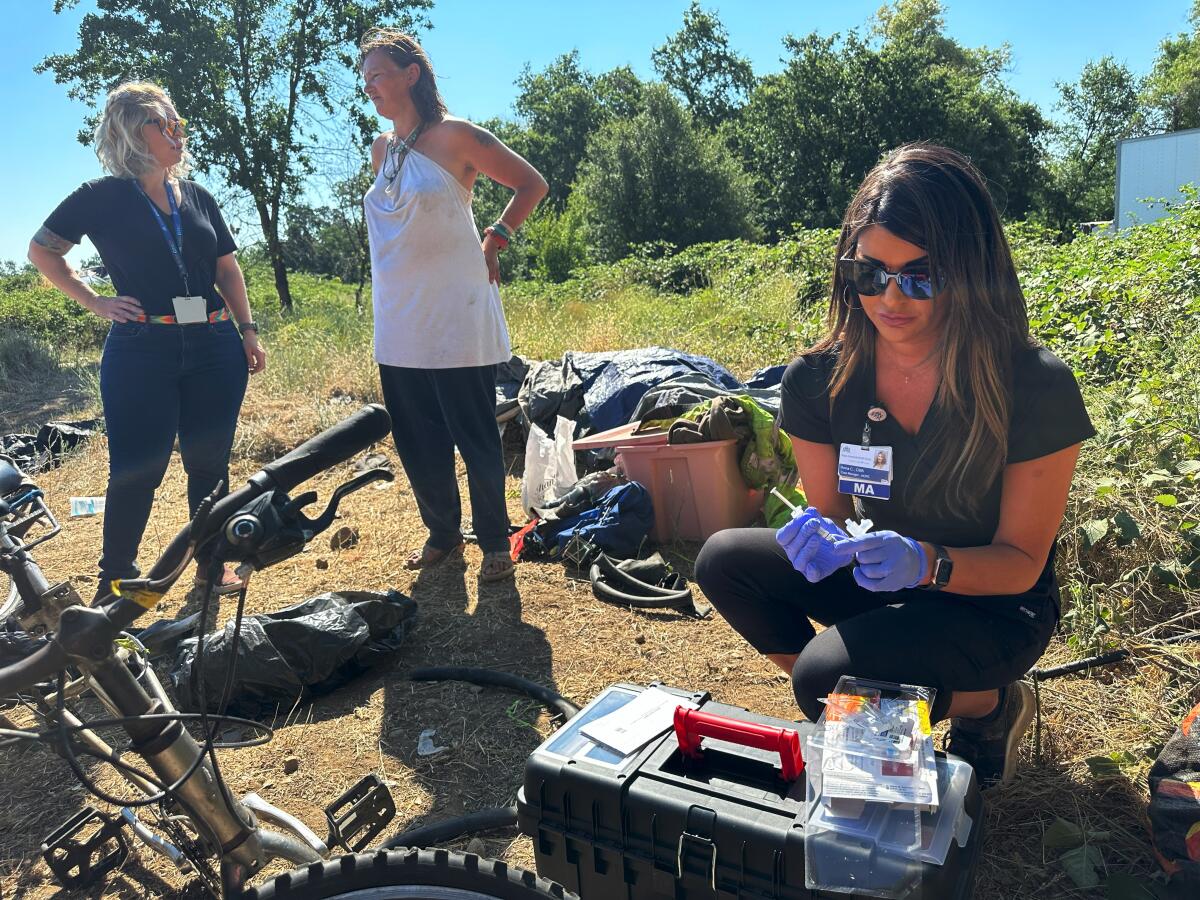
Street medicine nurse Anna Cummings, right, prepares an injection while Keri Weinstock, left, a psychiatric nurse practitioner, speaks with homeless patient Linda Wood.
(Angela Hart / KFF Health News)
Teams are usually composed of doctors, nurses and outreach workers, and are funded largely by health insurers, hospitals and community clinics that serve homeless people who have trouble showing up to appointments. That may be because they don’t have transportation, don’t want to leave pets or belongings unattended in camps, or are too sick to make the trip.
Feldman, who helped persuade Newsom’s administration to expand street medicine, notched a critical success in late 2021 when the state revamped its medical billing system to allow healthcare providers to charge the state for street medicine services. Medi-Cal had been denying claims because providers had treated patients in the field, not in hospitals or clinics.
“We didn’t even realize our system was denying those claims, so we updated thousands of codes to say street medicine providers can treat people in a homeless shelter, in a mobile unit, in temporary lodging or on the streets,” said Jacey Cooper, the state Medicaid director, who this month leaves for the Centers for Medicare & Medicaid Services to work on federal Medicaid policy. “We want to transition these women into housing and treatment to give them more hope of keeping their kids.”
The state isn’t pumping new money into street medicine, but primarily redirecting Medicaid funds that would have paid for services in bricks-and-mortar facilities.
Cooper has also pushed insurance companies that cover Medi-Cal patients to contract directly with street medicine teams, and some have done so.
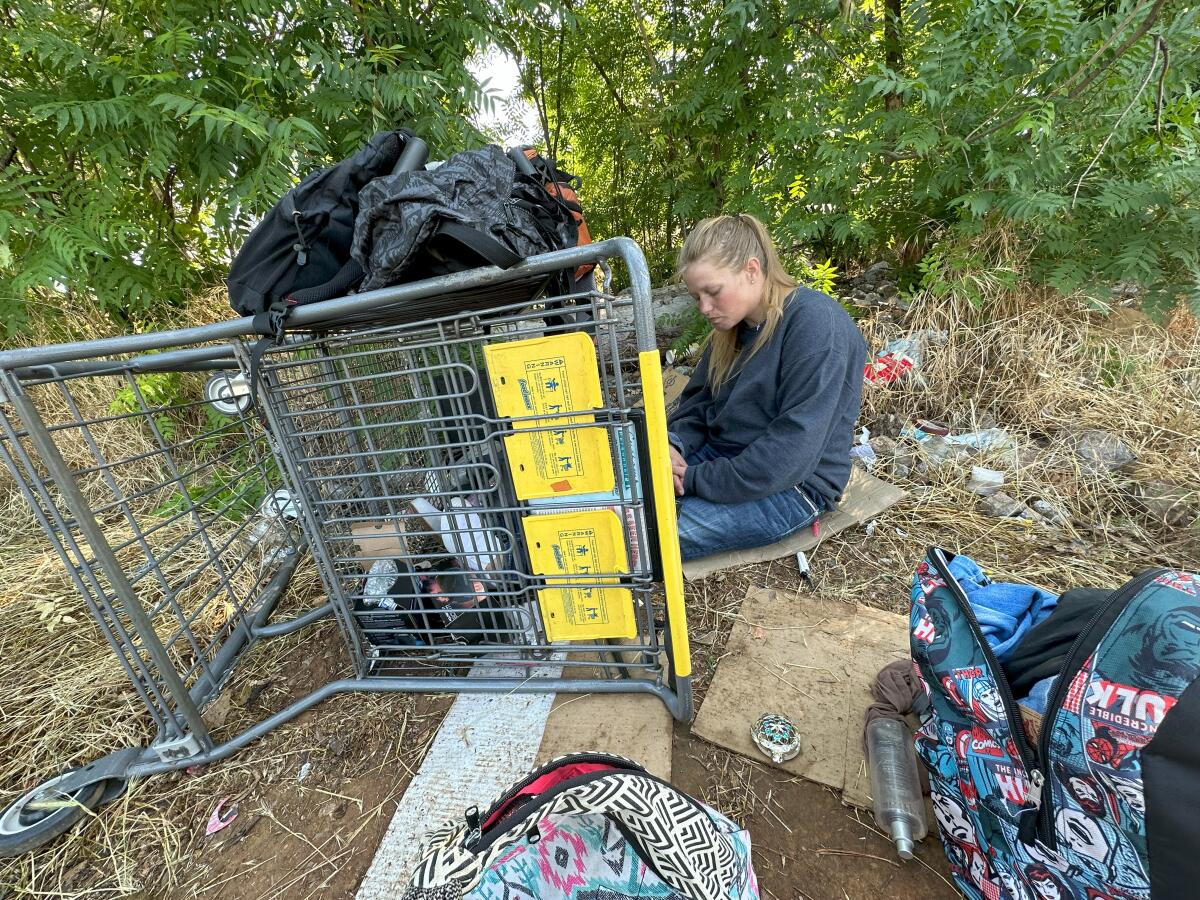
Lauren Hansen says she started using drugs after losing her baby in November. She endured a painful recovery in a roadside encampment in Redding.
(Angela Hart / KFF Health News)
Health Net, with about 2.5 million Medi-Cal enrollees across 28 counties, has contracted with 13 street medicine organizations across the state, including in Los Angeles, and is funding training.
“It’s a better use of taxpayer funding to pay for street medicine rather than the emergency room or constantly calling an ambulance,” said Katherine Barresi, senior director of health services for Partnership HealthPlan of California, which serves 800 homeless patients in Shasta County and contracts with Shasta Community Health Center.
Redding is the county seat of Shasta County, which has experienced a major political upheaval in recent years, driven in part by the anti-vaccine, anti-mask fervor that ignited during the COVID-19 pandemic and the Trump presidency.
Yet residents of all political stripes are growing frustrated by the surge in homelessness and open-air drug use — and the spillover effects on neighborhoods — and are pressuring officials to clear encampments and force people into treatment.
“I don’t care if you’re left, right, middle — what’s happening here is out of control,” said Jason Miller, who owns a sandwich shop called Lucky Miller’s Deli & Market. Miller said he’s had his windows smashed three times — costing $4,500 in repairs — and has caught homeless people defecating and performing lewd acts in his doorway.
Miller moved to Redding 15 years ago from Portland, Ore., after losing patience with the homeless crisis there, and tries to help, handing out shoes and food. He said he also understands that many homeless people need more services, such as street medicine.
“I get what they’re trying to do,” he said of street medicine providers. “But there’s a lot of questioning in the community around what they do. There’s no accountability.”
Patton isn’t deterred by the community’s skepticism or the cycle of addiction, even among his pregnant patients. The way he sees it, his job is to provide the best healthcare he can, no matter the condition his patients are in.
“It’s a lot of wasted energy, judging people and labeling them as noncompliant,” he said. “My job isn’t to determine if a patient is deserving of healthcare. If a patient is sick or has a disease, I have the skills to help, so I’m going to do it.”
Shasta County, like much of California, is seeing its homeless population explode — and get sicker. An on-the-ground count this year identified 1,013 homeless people in the county, up 27% from 2022. Most are men, but women account for a growing share of Patton’s patients because “more and more are getting pregnant,” he said.
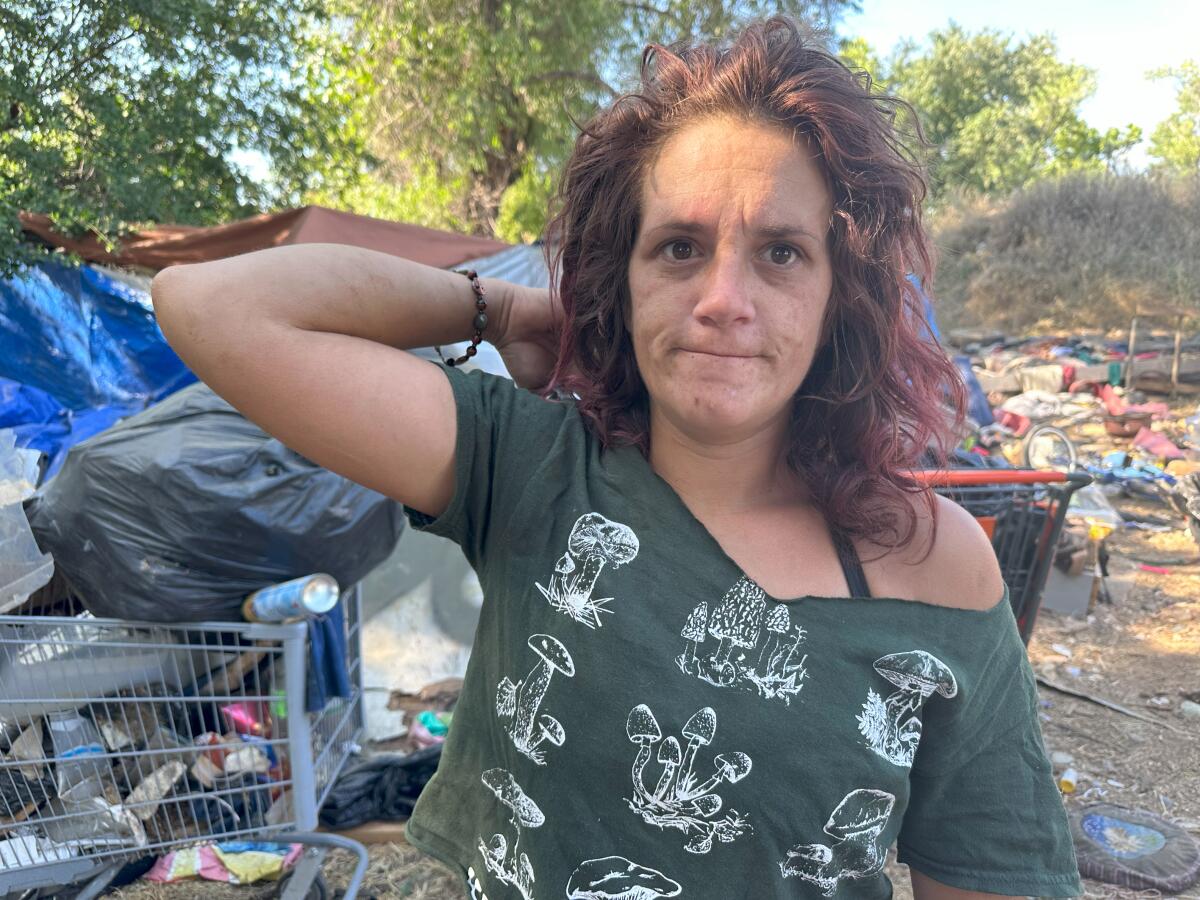
Stephanie Meyers has given birth to four children while living on the streets. Street medicine doctor Kyle Patton implanted long-acting birth control in her arm in June.
(Angela Hart / KFF Health News)
County welfare agencies have little choice but to separate babies from their mothers when substance use or homelessness presents a risk to the children, said Amber Middleton, who oversees homelessness initiatives at Shasta Community Health Center.
“We are off the charts with maternal substance abuse,” said Middleton, who previously worked for Shasta County’s child welfare agency. “A lot of these women are trying to get clean so they can get their children back, but they’re also trying to give themselves the childhood that they never had.”
Crespo turned to alcohol and drugs to deal with deep emotional pain from her youth, when she was passed among family members and, she said, beaten repeatedly by one of them. “He would give me black eyes and I would run away,” she recalled in tears, admitting that she has perpetuated that cycle of violence by punching her former husband when she felt provoked.
She has overdosed “more times than I can remember,” she said, and she credits naloxone, an opioid overdose reversal drug, for saving her life repeatedly.
Patton routinely tests Crespo and other patients for sexually transmitted infections, gets them on prenatal vitamins and treats underlying conditions such as high blood pressure that can lead to a high-risk pregnancy. And he’s helping women get sober, often using a drug called Suboxone, which is a combination of two medications used to treat opioid addiction. Its forms include a strip that providers snip to make the needed dose.
“A lot of these women have already had children removed, and many are pregnant again,” he said. “If I can get them on Suboxone, they’re going to have a better chance of being successful as a family when they deliver.”
On that sweltering June day, he met Tara Darby, who was on fentanyl and meth and living in a tent along a creek that feeds into the Sacramento River. Patton started her on a course of Suboxone and got her into a hotel with her boyfriend to help her deal with the initial detox.
He also administered a pregnancy test and discovered she was already a few months along. “It’s rough out here. There’s no bathroom or water, you’re nauseous all the time,” Darby, 40, said. “I want to get out of this situation, but I’m terrified about getting clean, the detox, having my baby.”
When Patton offered her support from a drug and alcohol treatment counselor, Darby promised to try. “I want to do it. I have the willpower,” she said.
Across town, Kristen St. Clair was nearly seven months pregnant and living in a hotel paid for by Shasta Community Health Center. Patton was helping her and her boyfriend, Brandt Clifford, get off fentanyl. “I want to have a healthy, happy life with my baby,” said St. Clair, 42, who already had one baby taken from her largely because of her drug use. “I’m worried it’s too late now.”
But the prospect of getting clean felt daunting. Clifford, the father of her child, is an Iraq war veteran with a traumatic brain injury. He had overdosed the previous day and needed five doses of naloxone to come back. “We saved your life, man,” Patton told Clifford.
Patton snipped a strip of Suboxone, explaining that addiction is complicated.
“Science is showing that, for whatever reason, certain people were born with the right mix of genetic predisposition and then have had various things happen to them in their lives, which are unfair,” he said. “And then when you tried opioids for the first time, your brain said to you, ‘This is the way I am supposed to feel.’ It takes very little to get hooked.”
Despite their desperation to kick their drug habit, St. Clair and Clifford have since relapsed, Patton reported. St. Clair delivered in early September, and her boy was taken into custody to “withdraw in a neonatal abstinence program,” Patton said.
Darby, who was evicted from her hotel room after relapsing, was in residential treatment to get sober as of early October.
Crespo is making headway, Patton said. She and her boyfriend, Andy Gothan, 43, are staying at a hotel while Patton’s team helps her look for a landlord who will accept a low-income housing voucher.
“I’m so close, they’ve helped me so much,” Crespo said. Meth is “always around, always available. If I can get inside, it’ll help me deal with the stress of getting clean without all those triggers.”
This article was produced by KFF Health News, a national newsroom that produces in-depth journalism about health issues.

Science
Drug overdose deaths plummet in San Francisco. What's changed?

SAN FRANCISCO — After surging during the COVID pandemic into a crushing public health emergency, drug overdose deaths in San Francisco plummeted in 2024, according to preliminary data compiled by city health officials.
The chief medical examiner’s office recorded 586 fatal overdoses in San Francisco in the first 11 months of 2024. That represents a nearly 23% decrease, or 174 fewer deaths, compared with the first 11 months of 2023. In total, 810 people died from drug overdoses in 2023, the highest number in city records.
The development mirrors both national and statewide data showing overdose deaths on the decline. Provisional data from the federal Centers for Disease Control and Prevention indicate a 14.3% decrease in fatal overdoses across California when comparing the 12 months that ended in July 2023 with the 12 months that ended in July 2024. Fatal overdoses fell 16.9% nationwide during that period, according to CDC figures.
Los Angeles County health officials have not yet released fatal overdose figures for 2024. But the most recent data also showed progress: Deaths from drug overdoses and poisoning plateaued between 2022 and 2023, after years of historic increases, according to the L.A. County Department of Public Health. In 2023, the county recorded 3,092 fatal overdoses, down slightly from 3,220 deaths the year before.
San Francisco public health experts attributed the decline in fatal drug use in the city to the widespread availability of naloxone, a medication commonly sold under the brand name Narcan that can rapidly reverse the effects of opioid overdoses, as well as buprenorphine and methadone, prescription medications that treat opioid addiction long-term.
“We are cautiously optimistic that our public health interventions are starting to see results in terms of saving lives,” said Dr. Grant Colfax, director of the San Francisco Department of Public Health.
Methadone prescriptions issued by the health department increased by more than 30% and buprenorphine prescriptions by nearly 50% in the last year, Colfax said. The department recently partnered with a “night navigator team” that works after dark to offer treatment, including a telehealth program that quickly connects people who abuse opioids with healthcare providers who can prescribe medications. The department has logged more than 2,300 calls since the program launched in March.
San Francisco has added about 400 residential treatment beds to 2,200 existing spots in recent years and tripled the number of street care workers in the last two years, according to the public health department and Mayor London Breed’s office.
Dr. Christopher Colwell, chief of emergency medicine at Zuckerberg San Francisco General Hospital and Trauma Center, said he has seen a notable increase in the number of people open to accepting treatment in the last year.
“I think a lot of patients are recognizing, more so in the last year than I’ve ever seen, how dangerous opioid use disorder is, watching their friends and colleagues die,” Colwell said. “I’ve seen a lot more willingness to at least have that discussion, and consider it, than I did even just a couple years ago.”
Keith Humphreys, a Stanford University psychiatry professor who studies addiction, called the 2024 numbers a “big deal.”
“Both because of the lives that are saved, but also just for the morale of every front-line worker, every harm-reduction worker, every treatment professional, every police officer who has been despairing that this is never going to get better,” Humphreys said. “This is a big boost.”
San Francisco, like many urban areas, recorded a sharp rise in fatal overdoses in the early years of the COVID pandemic, when government shutdowns made it more difficult to directly address the introduction of fentanyl into the street drug scene. For example, San Francisco counted 259 deadly overdoses in 2018, when fentanyl first hit the streets, and 441 fatalities in 2019. A year later, as the city effectively shut down to slow the spread of COVID-19 and it became more difficult to do community outreach, overdose deaths skyrocketed to more than 720.
Humphreys said the pandemic’s wane has also made it easier to address some of the social factors underlying addiction.
“Everything about COVID was terrible from a drug viewpoint. You had more reasons to use drugs: sadness, isolation, bereavement, loneliness,” Humphreys said. “The kind of structures that help people get and stay in recovery, like work, accountability, daily routines, social obligations, all went down.”
Breed lost her November reelection bid to nonprofit executive and Levi Strauss heir Daniel Lurie, a result widely attributed to voter frustration over homelessness and street drugs. Still, Breed said the recent decline in overdose deaths is a testament to her administration’s decision to take a “harder stance” against illicit drug use, arresting dealers and mandating treatment for some users.
Last March, for example, she sponsored a successful ballot measure to require drug screening and treatment for people receiving county welfare benefits who are suspected of illicit drug use.
Colwell said that although last year’s numbers are a positive sign, opioid use remains a serious problem. He stressed the importance of adding treatment options such as buprenorphine and methadone, which are more effective long-term than overdose reversal medications. And although he appreciates the city’s efforts to invest in treatment beds and housing, he said, “I don’t go a day where I don’t feel like we need more.”
He and other experts said it is crucial that the city and Lurie continue investing in solutions, even as San Francisco faces a projected $876-million budget shortfall. Lurie has pledged to declare a fentanyl emergency when he takes office Jan. 8 and to “get tough” on drug dealers.
“We’ve seen what can be helpful,” Colwell said, “and we need to keep doing this.”
Science
U.S. norovirus cases spiking this holiday season. Here's how to avoid the stomach bug

With the winter cold and flu season upon us, Americans should be on the lookout for another ultra-contagious virus: our most common stomach bug.
The U.S. experienced the largest December norovirus surge since at least 2012, according to data from the Centers for Disease Control and Prevention.
During the week of Dec. 5, state health departments recorded 91 separate outbreaks nationwide, according to the CDC. The next highest figure for that week since 2012 was 65 outbreaks.
Through November, there have been 55 laboratory-confirmed cases of norovirus in California, according to the state department of public health. Data from December are not yet available.
Outbreaks are typically more widespread in January and February, the data show, raising concerns that the spike could continue.
Most norovirus cases are transmitted directly from one person to another, the CDC said, from actions such as touching food or eating utensils. Restaurants, cruise ships, healthcare facilities and schools are common transmission sites.
Additionally, contaminated food, water and surfaces can spread the virus.
Last week, the U.S. Food and Drug Administration issued advisories warning businesses and consumers against serving or eating oysters from Washington state, Canada and Korea which may be contaminated with norovirus.
Annually, the CDC reports some 2,500 outbreaks nationally. But real-time monitoring data only cover 14 states: Alabama, Colorado, Massachusetts, Michigan, Minnesota, Nebraska, New Mexico, North Carolina, Ohio, Oregon, South Carolina, Tennessee, Virginia and Wisconsin.
Around half of outbreaks of food-related illness are caused by norovirus, per the CDC.
The most common symptoms of norovirus are vomiting, diarrhea, nausea and stomach pain. Symptoms usually improve in one to three days, but those infected can still spread the virus for several days after symptoms ease.
The best ways to prevent the virus from spreading: washing hands, cooking shellfish thoroughly, washing fruits and vegetables, cleaning and disinfecting contaminated surfaces, washing laundry in hot water and staying home for two days after symptoms stop.
The main treatment for norovirus is hydration to replace fluids lost by the patient. Those with severe dehydration should seek medical attention, the CDC advises.
Science
Can probiotic supplements prevent hangovers?

The ads on podcasts and social media were tantalizing: over-the-counter probiotic supplements that could ward off the worst effects of a hangover if taken before drinking.
As a bourbon reviewer who enjoys the flavor of spirits but has always been easily prone to hangovers, Eric Burke was intrigued. He ordered a few bottles of Pre-Alcohol, a probiotic drink from the company ZBiotics, to test it out.
He downed the mixture of water, salt, flavoring and genetically modified bacteria. He followed it with a cocktail, a meal and two bourbons, and woke the next morning feeling considerably more chipper than he’d have expected.
The next night, emboldened by success, he drank another half-ounce bottle of Pre-Alcohol. He drank a bit more than the previous night — a beer with dinner and then four tumblers of bourbon.
That amount that typically would leave him feeling achy and sluggish the day after.
Which was exactly how he felt when he opened his eyes hours later.
“That one was unpleasant,” said Burke, 48. “I woke up that morning being just like, ‘Well, I’m not 21 anymore.’ ”
A hangover is a collection of physical and mental symptoms resulting from the inflammation and oxidative stress that alcohol wreaks in the human body.
One of many factors contributing to day-after misery is the accumulation of acetaldehyde, a chemical byproduct of the beverages’ ethanol breaking down in the body. Acetaldehyde is a carcinogen that features prominently in the nausea, stomach upset, sweats and other physical symptoms associated with over-consumption.
ZBiotic’s Pre-Alcohol and the Swedish biotech company De Faire Medical AB’s competitor supplement Myrkl both rely on live bacteria to process excess acetaldehyde. Other researchers and recreational drinkers have also experimented with probiotics for similar ends.
Reducing the amount of acetaldehyde, the hypothesis goes, should also reduce the physical symptoms caused by its buildup.
A bartender holds a martini with lemon.
(Myung J. Chun / Los Angeles Times)
“The more you drink, the more you’ll have to deal with the effects of other things besides acetaldehyde,” ZBiotics CEO Zack Abbott said via email when asked about Burke’s results. “That being said, for the vast majority of people, acetaldehyde is a major factor, and Pre-Alcohol therefore results in them feeling better (if not perfect) the next day.”
The U.S. Food and Drug Administration considers ZBiotics and Myrkl to be dietary supplements or functional foods, not drugs, and thus doesn’t evaluate their health claims. Microbiome experts caution that a probiotic supplement alone won’t spare you from the worst effects of overindulgence.
For starters, the bloodstream carries most of the ethanol in an alcoholic beverage straight to the liver, where an enzyme called alcohol dehydrogenase breaks it down into acetaldehyde. The brain, gastrointestinal tract and pancreas process some alcohol as well. Only a relatively small amount of ethanol is metabolized in the intestines, where probiotics do their work.
Adding probiotics to your pre-party regimen won’t cause you any harm, said Karsten Zengler, a microbiologist and professor of pediatrics and bioengineering at UC San Diego.
But it’s also unlikely to have a substantial effect on how you feel the next day, as your intestines come pre-equipped with an army of bacteria capable of breaking down alcohol’s byproducts, he said.
“There is not a lot of ethanol and acetaldehyde in your large intestine to start with,” Zengler said, and “the vast majority of the bacteria in your gut already metabolize acetaldehyde for you, so just adding something more might not do the trick.”
ZBiotics has funded studies demonstrating both the safety of their product and that their bacteria effectively broke down a significant amount of acetaldehyde in simulated gut conditions in a lab. As for the real-world effects of that breakdown, Abbott pointed to an outside 2006 paper that found that rats given ethanol had fewer hangover-like symptoms the next day when acetaldehyde was removed.
Myrkl funded a small study that showed its product lowered blood-alcohol levels in some participants. Subjects were instructed to take the supplement for a week prior to drinking, rather than the single pre-party dose instructed on the packet.
The hard truth, said Joris C. Verster, a pharmacology professor at Utrecht University in the Netherlands and founder of the Alcohol Hangover Research Group consortium, is that there is currently one scientifically validated way to prevent hangovers: drink less alcohol.
“Although there are many hangover products marketed, there is no convincing scientific evidence that these treatments are effective. Independent double-blind, placebo-controlled clinical trials in social drinkers are needed,” Verster said. “Currently, the only effective way to prevent a hangover is to consume alcohol in moderation.”
Unpleasant as they are, hangovers serve a valuable purpose, said Dr. Daryl Davies, a clinical pharmacy professor and director of the Alcohol and Brain Research Laboratory at USC Mann School of Pharmacy and Pharmaceutical Sciences.
“What I tend to tell people is if you are getting hangovers, you are drinking too much,” Davies said. “It is the body trying to tell you that something is wrong.”
-
/cdn.vox-cdn.com/uploads/chorus_asset/file/25672934/Metaphor_Key_Art_Horizontal.png)
/cdn.vox-cdn.com/uploads/chorus_asset/file/25672934/Metaphor_Key_Art_Horizontal.png) Technology1 week ago
Technology1 week agoThere’s a reason Metaphor: ReFantanzio’s battle music sounds as cool as it does
-

 News1 week ago
News1 week agoFrance’s new premier selects Eric Lombard as finance minister
-

 Business1 week ago
Business1 week agoOn a quest for global domination, Chinese EV makers are upending Thailand's auto industry
-

 Health5 days ago
Health5 days agoNew Year life lessons from country star: 'Never forget where you came from'
-
/cdn.vox-cdn.com/uploads/chorus_asset/file/24982514/Quest_3_dock.jpg)
/cdn.vox-cdn.com/uploads/chorus_asset/file/24982514/Quest_3_dock.jpg) Technology5 days ago
Technology5 days agoMeta’s ‘software update issue’ has been breaking Quest headsets for weeks
-

 World1 week ago
World1 week agoPassenger plane crashes in Kazakhstan: Emergencies ministry
-

 Politics1 week ago
Politics1 week agoIt's official: Biden signs new law, designates bald eagle as 'national bird'
-

 Politics7 days ago
Politics7 days ago'Politics is bad for business.' Why Disney's Bob Iger is trying to avoid hot buttons













